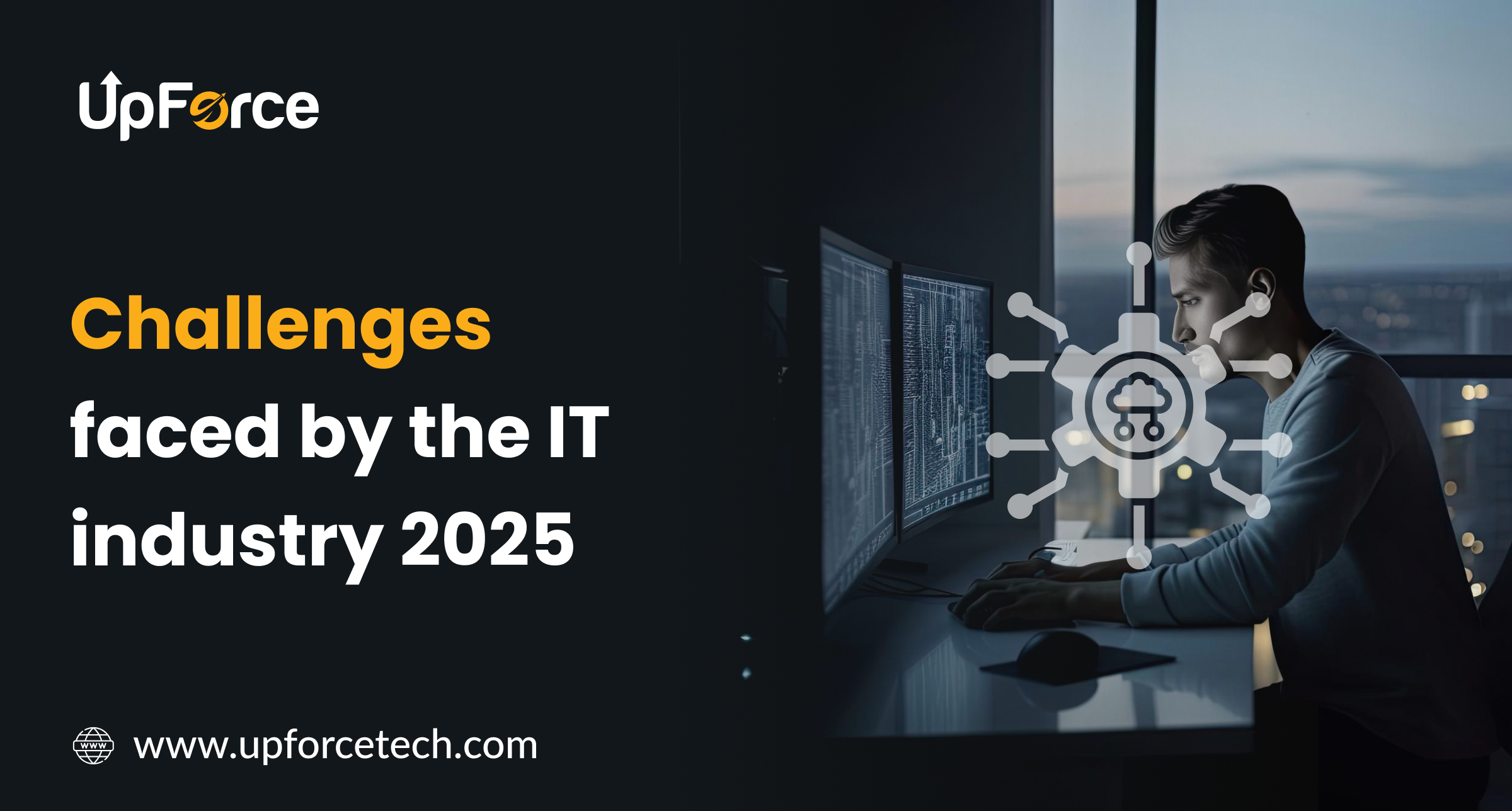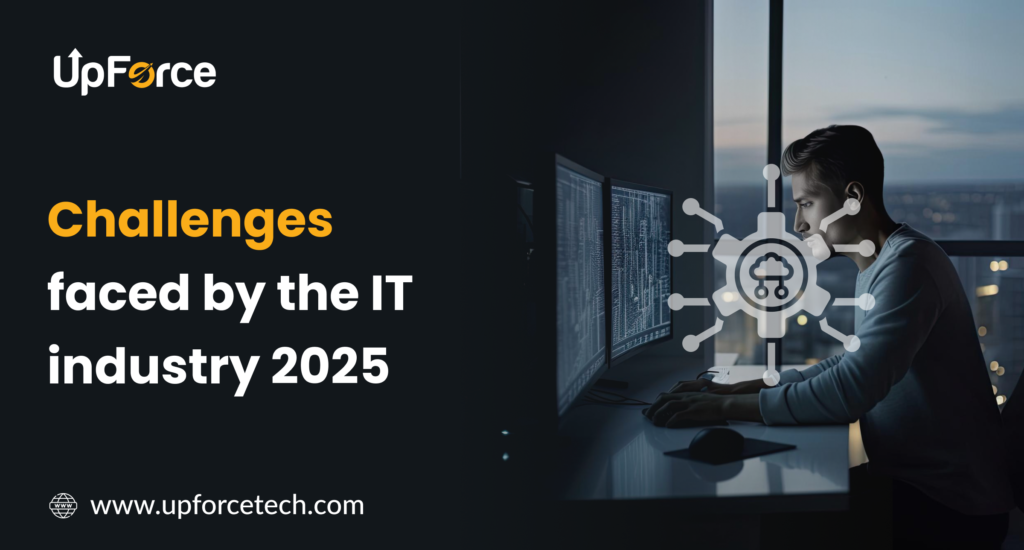Challenges Faced by the IT Industry in 2025
Table of Contents
Challenges Faced by the IT Industry in 2025
The IT industry is evolving at an unprecedented pace, driven by advancements in artificial intelligence (AI), cloud computing, cybersecurity, and automation. While these innovations open new opportunities, they also bring complex challenges that businesses must tackle to stay ahead.
As we move into 2025, IT companies, professionals, and decision-makers must prepare for the obstacles ahead. In this blog, we’ll explore the biggest challenges facing the IT industry in 2025 and provide actionable solutions to navigate them effectively.

1. The Growing Talent Shortage in IT
The Challenge
The demand for skilled IT professionals is outpacing supply, particularly in high-demand areas like cybersecurity, AI, and cloud computing. By 2025, it’s estimated that the global shortage of tech talent will reach 85 million workers, costing companies trillions in lost revenue. (Source: Korn Ferry)
Solution
- Upskilling and Reskilling Employees: Companies should invest in employee training programs to keep their workforce updated with the latest skills.
- Remote Work and Global Hiring: Expanding the talent pool by hiring remote workers from different countries can help bridge the gap.
- Stronger Collaboration with Universities: Partnering with educational institutions can ensure a steady pipeline of skilled graduates entering the workforce.
Related Resource: How to Build an AI-Ready Workforce
2. The Rise of Cybersecurity Threats
The Challenge
As businesses embrace cloud computing, IoT devices, and remote work, cybersecurity threats are becoming more sophisticated. Cybercrime is predicted to cost the world $10.5 trillion annually by 2025 (Source: Cybersecurity Ventures)—a figure that should alarm every organization.
Solution
- Zero-Trust Security Model: Implement strict access controls where no user or device is automatically trusted.
- AI-Powered Threat Detection: AI and machine learning can analyze patterns and detect potential security breaches faster.
- Employee Cybersecurity Training: Since human error is the leading cause of cyberattacks, regular training is crucial.
Recommended Read: Cybersecurity Best Practices for 2025
3. The Complexity of Managing Cloud Costs
The Challenge
Cloud computing offers scalability and flexibility, but many companies struggle with uncontrolled cloud costs, leading to budget overruns. A Gartner report found that 80% of businesses will overspend on cloud services by 2025 due to lack of cost optimization.
Solution
- Implement FinOps (Cloud Financial Management): A dedicated FinOps team can monitor cloud spending and optimize resources.
- Use Multi-Cloud Strategies: Instead of relying on a single cloud provider, businesses can optimize costs by balancing workloads across multiple providers.
- Automate Cloud Resource Allocation: AI-driven tools can predict cloud usage patterns and scale resources accordingly.
Further Reading: Cloud Cost Optimization Strategies
4. AI and Automation Replacing Jobs
The Challenge
Automation is reshaping industries, and IT is no exception. While AI improves efficiency, it also raises concerns about job security. According to the World Economic Forum, AI could replace 85 million jobs by 2025, but it will also create 97 million new roles.
Solution
- Encourage a Mindset Shift: Companies should promote AI as a tool for enhancing human work rather than replacing jobs.
- Reskilling and Job Redefinition: Employees should be trained to work alongside AI, leveraging automation to improve productivity.
- AI Ethics and Governance: Establishing guidelines on ethical AI implementation can help reduce fears and ensure fair job distribution.
Recommended Read: The Future of AI and Jobs
5. Rising IT Infrastructure Demands
The Challenge
The surge in data-driven applications, 5G connectivity, and IoT devices is putting pressure on IT infrastructure. Companies need faster networks, better storage solutions, and more scalable architectures to keep up with growing demands.
Solution
- Adopting Edge Computing: Processing data closer to the source reduces latency and improves performance.
- Hybrid IT Solutions: A mix of on-premise and cloud computing can offer flexibility and scalability.
- Investing in 5G and Next-Gen Data Centers: Faster connectivity can support real-time applications and massive data transfers.
Explore More: How Edge Computing is Transforming IT
6. The Rapid Evolution of Tech Stacks
The Challenge
New programming languages, frameworks, and tools are emerging rapidly. Businesses that fail to adapt to modern tech stacks risk falling behind.
Solution
- Continuous Learning Culture: Encourage IT teams to stay updated with the latest technologies.
- Flexible Architecture: Implement microservices and API-driven development for easier tech stack updates.
- Community Engagement: Active participation in open-source communities can help stay ahead of trends.
Related Read: Top Tech Stacks for 2025
Conclusion
The IT industry in 2025 is facing significant challenges, but also great opportunities for those who are prepared. Companies that invest in talent, embrace AI and automation, strengthen cybersecurity, and optimize cloud strategies will be well-positioned for success.
Adapt, innovate, and stay ahead of the game!
How UpforceTech Can Help You Hire the Right Contract Developer
At UpforceTech, we specialize in connecting businesses with highly skilled contract developers who can meet their unique needs. Our rigorous vetting process ensures that you get access to the best talent, whether you need someone with expertise in front-end development, back-end systems, or mobile app development.
Here’s how UpforceTech can support your business:
- Access to a Global Talent Pool: We provide access to a diverse range of developers from around the world, ensuring you find the right fit for your specific project needs.
- Customized Hiring Solutions: Whether you’re looking for short-term contract developers or long-term project-based teams, we tailor our services to fit your requirements.
- Quality Assurance: Every developer in our network goes through a comprehensive screening process to ensure they have the necessary skills and experience to deliver high-quality work.
- Ongoing Support: Our commitment doesn’t end with hiring. We offer ongoing support to ensure a seamless integration of contract developers into your team.
For more information on how to get started with hiring contract developers, visit UpforceTech.
Are you looking to Grow your business with skilled developers? Hire a contract developer today to bring fresh ideas and expertise to your team. Learn how UpforceTech can help!
Sign up for the free Newsletter
"The IT industry isn’t just about technology—it’s about people adapting, learning, and innovating every day."
UpforceTech
FAQs
The biggest challenges include a talent shortage, cybersecurity threats, cloud cost management, AI-driven job disruptions, and rising infrastructure demands.
Implementing AI-powered threat detection, training employees, and adopting a zero-trust security model can significantly reduce risks.
FinOps is a cloud financial management strategy that helps businesses control cloud spending while maximizing efficiency.
AI will automate repetitive tasks but also create new job opportunities, requiring employees to reskill and adapt.
Using multi-cloud strategies, AI-driven automation, and a dedicated FinOps team can help optimize cloud expenses.
Edge computing processes data closer to the source, reducing latency and improving application performance.
By investing in 5G, hybrid cloud solutions, and scalable architectures, companies can prepare for future demands.
AI, cloud computing, cybersecurity advancements, edge computing, and blockchain are some of the key trends shaping the industry.

